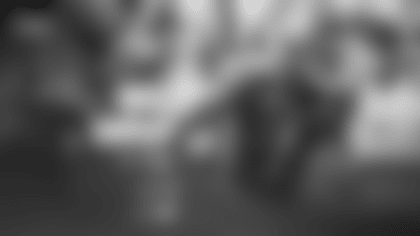It is hard to believe, but Jim Johnson has been gone for 10 years. It doesn't seem that long since he was prowling the sideline, dialing up exotic blitzes for his players to unleash on opposing offenses. Johnson retired after the 2008 season and passed away on July 28, 2009 after battling melanoma, a form of cancer.
The Eagles have been lucky to have some of the greatest defensive minds in the history of football. From Greasy Neale to Marion Campbell to Buddy Ryan to Bud Carson and now Jim Schwartz, that is an amazing tradition of defensive geniuses.
For my money, Jim Johnson is the greatest defensive coach in franchise history.
Andy Reid became the Eagles' head coach in 1999. Reid knew exactly who he wanted to be his defensive coordinator – Marvin Lewis. Fortunately, Lewis decided against taking the job. Reid turned to Johnson, who had impressed him while coaching the Colts' defense in 1997.
I didn't know a lot about Johnson when he was hired. There wasn't nearly as much football information out there back then, so it wasn't easy to keep up with every assistant coach around the league. I was happy that Johnson believed in the 4-3 defense and I was excited by the fact his defenses were so good at generating turnovers.
Johnson coached in Seattle in 1998 and that team made all kinds of plays. The Seahawks had 42 takeaways and scored 10 touchdowns! Those are insane amounts for a defense. The 1998 Eagles generated 17 takeaways, part of the reason they only won three games that season.
Johnson brought his attacking style of defense to Philadelphia and it worked right away. The Eagles led the NFL in takeaways in 1999, coming up with 46. They scored five touchdowns and made a lot of big plays. You could instantly see that Johnson's ideas worked.
The thing that impressed me so much about Johnson was how he adapted to his personnel. Some coaches believe in their system and if you don't fit it, they get rid of you. Johnson liked doing things a certain way, but he was creative when he had a talented player.
The two key players on the 1999 defense were Jeremiah Trotter and Brian Dawkins. Trotter was a complete unknown heading into the season and Dawkins was considered a solid player. Those don't sound like the guys who would become the stars of the defense, let alone Eagles Hall of Famers, but that's just what happened.
Trotter was a 260-pound sledgehammer. Most linebackers were in the 240-pound range. Trotter was built more like a defensive lineman, but that didn't scare Johnson away. He turned his new middle linebacker loose and let him attack. Trotter became much more than just a tackling machine.
Trotter was a downhill player who would fire into offensive linemen and blow them up on a regular basis. He proved to be a good blitzer. Not many running backs had any interest in blocking Trotter when he was charging into the backfield. Johnson was able to work on Trotter's coverage skills so he could be a three-down linebacker. Trotter broke up seven passes and picked off two others in 1999.
Dawkins was the player Johnson truly transformed. Johnson saw a player with immense talent. Rather than try to use Dawkins in a simple or traditional manner, Johnson got creative with his star pupil and unleashed Weapon X on the field.
The results were spectacular.
Dawkins earned his first trip to the Pro Bowl in 1999. He made plays all over the field. He picked off six passes, returning one for a touchdown. He had six forced fumbles and two fumble recoveries. Dawkins had 1.5 sacks and proved to be a very effective blitzer. Dawkins was still outstanding in coverage. He had 24 pass deflections that year.
Johnson moved Dawkins around like a chess piece. He might have Dawkins playing deep centerfield or right up on the line of scrimmage. Dawkins might be in man coverage on a back or a tight end. He might be blitzing off the edge. Quarterbacks never knew what to expect from Dawkins ... or Johnson. Dawkins would not be a Hall of Fame player without Johnson embracing him and finding so many creative ways to use him.
It wasn't just star players who thrived with Johnson's coaching. Nobody made a big deal of the Eagles signing linebacker Carlos Emmons. Johnson saw a perfect strongside linebacker in Emmons, someone who could stuff run plays and shut down tight ends in coverage. Johnson got the most out of role players like Paul Grasmanis, Rashard Cook, and Ike Reese. Quintin Mikell went from a backup to a role player to eventually a Pro Bowl selection.
When Johnson did get a star player, he was very creative. The Eagles signed Jevon Kearse prior to the 2004 season. Johnson made Kearse the star of his Okie package, a 3-3-5 look where Kearse would play middle linebacker. Kearse could move all over the field and rush the passer from a variety of spots. Blockers didn't know how to shift the protection scheme since they weren't sure where Kearse was coming from.
Johnson built strong game plans when he felt the opponent needed something special. The best example of that is the NFC Championship Game against the Falcons after the 2004 season. Johnson was at his best attacking passing quarterbacks, but Michael Vick and the Falcons were all about running the ball.
Johnson came up with a simple, but brilliant, twist. He moved Kearse from left end to right end and flipped Derrick Burgess to the left side. Vick was a left-handed quarterback and was at his best when he took off running to his left (the right side of the defense). Having an athlete like Kearse at right end took away Vick's advantage. Most defensive ends stood no chance going against Vick, but Kearse was called The Freak for a reason.
Johnson also had his ends come off the ball under control against the Falcons. He didn't want them attacking and getting out of position. He wanted them to focus on stopping the run and keeping Vick in the pocket. The Eagles were going to dare Vick to pass, which wasn't his strength.
Beyond that, Johnson wanted to confuse Vick with pre-snap looks. The Eagles didn't blitz much in the game, but did use a lot of eight-man fronts. Johnson had the extra defender come into the box at the last moment so Vick would have less time to read the defense and make a good initial read.
The game plan worked brilliantly.
Atlanta only scored 10 points and gained 202 yards. Vick ran for just 26 yards, was sacked four times, and he threw an interception. Kearse and Burgess were brilliant on the outside. Trotter controlled the middle of the field and Dawkins was all over the place. That win got the Eagles to the Super Bowl.
Kurt Warner and the Rams brought out creativity from Johnson. In the 2001 season opener, Johnson blitzed both of his outside corners on the same play. I had never seen that before. Why would you blitz Troy Vincent and Bobby Taylor, a pair of terrific cover corners? You do that because the Rams would never expect it. That was Johnson, always looking for some creative edge when facing a dynamic offense.
Johnson always seemed to get the best of another Hall of Fame quarterback in Brett Favre. In the seven regular-season and playoff meetings, the Eagles went 5-2. The Packers averaged just 13 points in those games. Favre threw four touchdowns against 12 interceptions. That's crazy.
Troy Aikman will tell you that one of the reasons his career ended when it did was the beating the Eagles put on him in the 2000 season opener. Aikman was knocked out of the game after starting 0-for-5. He missed the next couple of games and retired at the end of the year.
Another Dallas quarterback who also struggled against Johnson was Tony Romo. There was the 2008 regular-season finale when Romo's turnovers led to Philly touchdowns and the Eagles won 44-6. Romo's lowest passer rating in a game came against Johnson's defense. The Eagles won 10-6 in a 2007 meeting and Romo finished with a rating of 22.2. He was 13-of-36 and threw three interceptions that day. Fond memories.
Johnson was coaching at a time when NFL offenses were starting to come alive. Rules heavily favored offenses and coaches were getting more and more creative. Defensive coaches had to be at their best to deal with that.
Johnson also had success with a variety of players. He didn't build one good group and have them for five or six years. Johnson was coaching when player movement was a constant. You could build a solid core, but you were going to have new faces every year. Johnson handled that well and found ways to get the most out of the talent he had.
No matter what was going on, Johnson found a way to make things work. He was the Eagles defensive coordinator for 10 seasons. They went to the playoffs seven times and got to the NFC Championship Game in five of those years. That is an outstanding track record.
He had multiple top-five defenses. His teams won big games. The 2001 defense didn't allow any opponent in the regular season to score more than 21 points in a game. That is mind-blowing.
Jim Johnson came to Philadelphia as a respected veteran coach. He left the Eagles as a defensive genius, famed for his creative zone blitzes, double A-gap looks, and exotic game plans. He truly was a legendary coach.
Tommy Lawlor,goeagles99 on the Eagles Message Boards, is an amateur football scout and devoted Eagles fan. You can also find his work atIgglesBlitz.comwhere he is the site's editor.














